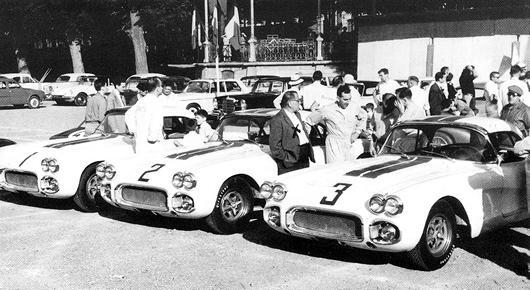Into The Sixties
Part Two – Text by Kane Rogers

The Cunningham Corvettes lined up for inspection, Le Mans 1960.
The number three car saved the day for Team Cunningham’s
return to the Sarthe. Lafay Photographic, BSC Collection.
The team prepared in typically thorough fashion. Briggs rented the circuit at Bridgehampton to run the cars for twenty-four hours, during which it was found that the stock wheels were prone to breaking. To solve this and to facilitate quicker pit stops, Momo not only switched to knock-off magnesium Halibrands, but he also fitted the cars with huge aircraft-type fuel fillers, situated behind cutouts in the rear windows of their anchored hardtops.
While thankful for the factory’s back-door support, Alfred was less than welcoming of the advice coming from Corvette godfather Zora-Arkus Duntov, who had wanted the cars to run with his new aluminum heads. Momo’s watchword was still reliability, so he eschewed the untested alloy units in favor of the proven cast-iron ones, which he prepared himself in the interest of better breathing. Driver comfort and information were also important, so the cars were equipped with adjustable steering wheels, extra instrumentation and padded bucket seats.
Dan Gurney, who had left Ferrari for BRM and was available to drive a sports car, was paired with Walt Hansgen in the Jaguar. In the Corvettes, Briggs would share duties with up-and-coming Bill Kimberly, Fred Windridge joined Dick Thompson and John Fitch would co-drive with Bob Grossman.
Rain threatened early Saturday evening, just as Bill Kimberley was taking over from Briggs’ first stint. Alfred was arguing with Firestone engineers, who wanted to save their rain tires until absolutely necessary. Three-quarters of a lap later, their concern was rendered moot when Kimberly drove head on into a wall of rain, losing the car in a series of rolls, then miraculously escaping unhurt before the car burned to the ground.
Dick Thompson, ever the charger, drove the number two ‘Vette straight into the sandbank at Mulsanne, destroying a large portion of its bodywork, before digging out over an hour later. Thompson’s co-driver, Fred Windridge, managed on Sunday morning to inject some humor into Team Cunningham’s now seemingly desperate fortunes when his Corvette, still streaming the tatters of its few remaining bits of fiberglass bodywork, blew its engine in a cloud of smoke and glory as it passed the pits. Unable to make the escape road, Windridge exited the car as it was swarmed by firemen, medical attendants, gendarmes and track marshalls all nattering at him in French about where to push the car. Recognizing a nearby photographer who was a local friend of Team Cunningham, Freddy shouted to him, “Please tell them to leave the car alone! You know how fussy Briggs is!”
Meanwhile, the number 3 Fitch/Grossman Corvette was steadily proceeding, making its way up to seventh place by morning, ahead of all but one Ferrari in the GT class. The car made it as high as fourth until, with one hour to go, its engine began to overheat and lost most of its coolant. The rules were not kind to the Corvette’s predicament; each car had to circulate for twenty-four laps between top-ups to its oil and water, and had to complete at least four laps in the last hour to qualify as a finisher.
The answer lay in Team Cunningham’s overwhelming preparation: among its many supplies was a huge cache of ice to preserve the vast quantities of food and drink they brought with them to the race. One of the crew members suggested packing the ‘Vette’s engine compartment with ice, which prompted Momo to instruct Grossman to turn a series of fifteen-minute laps, each of which would end with another trip to the pits for more ice. The fans and the PA announcers ignored the winners-to-be from Ferrari and began cheering on the staggering Corvette, which finally finished eighth overall with an average speed of 97.92mph.
“The car was popping and spitting and looked like it might not last,” recalled Grossman. “At the finish, I was mobbed by Americans- so many I couldn’t get out. A very emotional moment. I’ll never forget it.”
Website Disclaimer
Please read the disclaimer prior to entering this website. You may access it by clicking here.